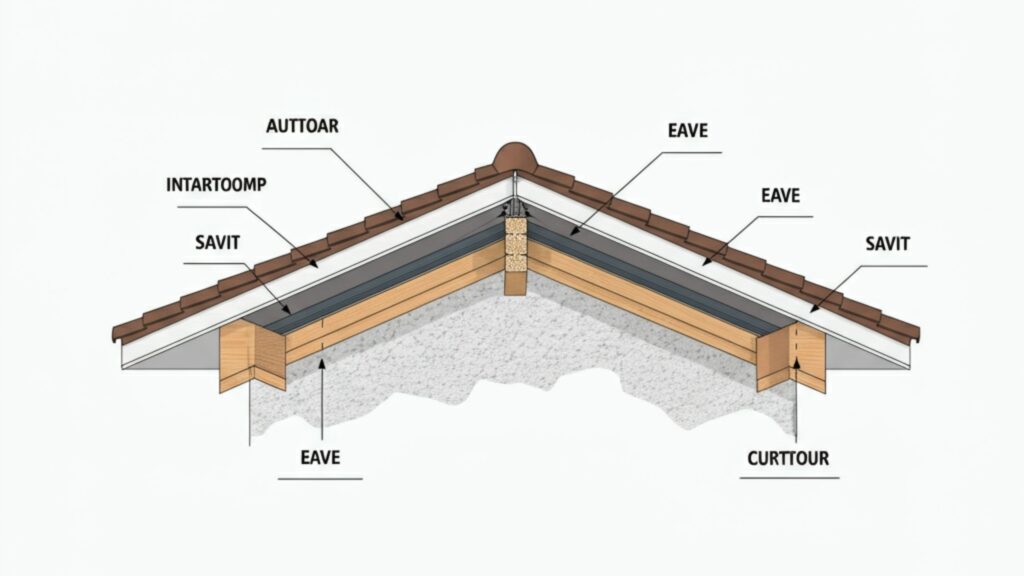
Alright, picture this. You’re outside your house on a rainy day, and instead of water drenching your walls and windows, it gently flows away like magic. That superhero behind the scenes? Your roof eaves. They’re like the tiny protective canopy you didn’t know your home absolutely needs. But, what are roof eaves exactly? They’re not just fancy architectural extras; they’re hard workers disguised as charmers for your home.
Imagine your roof sticking out beyond the walls of your house. That overhang? Bam! That’s your roof eave. It’s a quiet multitasker, actively protecting your walls, doors, and foundation from getting soaked. But it’s so much more than rain-repellent. Eaves also make your home look polished and cozy. Think of them as the bow on a perfectly wrapped present.
What Are Roof Eaves?

Alright, let’s break it down simply. Picture your roof as a superhero cape. Wherever it extends beyond the walls of your house, that’s what we call eaves. They’re like the multi-tasking friend who looks good AND does all the hard work quietly. Roof eaves aren’t just decorative frills; they’re your home’s star defender against rain, sun, snow, and even pesky critters.
Ever wondered why birds perch under rooftops during a drizzle? That’s because your eaves create a handy overhang, shielding everything underneath from the weather. However, their role goes beyond being a cute bird umbrella. They keep your house cool, protect your walls from ruin, and even reduce energy bills. They’re awesome, right?
Your Roof’s Best Friend
Think of eaves as a team player. Without them, your home would be like a hockey goalie without protection gear. Rain would batter your walls, water would seep into cracks, and sunlight would heat your interiors until you’re sweating buckets. Roof eaves take care of all that behind the scenes, leaving you with a cozy, protected house.
Take rainfall, for example. Ever noticed how water doesn’t dribble down the walls on a rainy day when eaves are around? Instead, it neatly flows into gutters, thanks to these overhangs. This redirecting magic saves your foundation, prevents mold, and keeps your house looking neat. Plus, it spares you the joyless job of scrubbing mildew off your walls!
Inside the Eaves Crew
Let’s meet the hardworking parts of an eave, each playing a vital role in the team effort to protect your home.
1. Rafters
Rafters are kind of like the bones of your roof eaves–but sturdy ones. These beams extend from the roof and give the eaves their shape and strength. Without rafters, you wouldn’t have an overhang in the first place!
2. Fascia
Think of fascia as the sharp suit your house wears. This flat panel along the edge of the rafters not only makes things look seamless but also serves as an anchor for your gutters.
3. Soffit
The soffit is like the ceiling under the eaves. It’s where the magic of airflow happens (through tiny vents), keeping your attic cool and dry. Bonus? It also makes your roof look tidy from below. Who doesn’t love a neat underbelly?
4. Drip Edge
This little superhero cape extension eliminates annoying water drips by redirecting rain away from your home.
5. Gutters
Gutters and eaves go hand in hand, like peanut butter and jelly. The eaves send water toward gutters, and gutters carry that water off to places where it won’t cause trouble.
Why Do Eaves Even Matter?
If you’ve made it this far, you’re probably thinking, “Okay, cool info. But why should I care?” Fair point. Roof eaves might not be glamorous, but skipping them is like forgetting sunscreen on a blazing sunny day. Here’s why they matter:
- Weather Warrior: Think about this–without eaves, rain could splash against your walls, windows, and doors every time it drizzles. Over time, that’s a ticket to peeling paint, soggy spots, and worse, structural damage.
- Energy Saver: Roof eaves throw just the right amount of shade on sunny days, cooling your house naturally and keeping your energy costs in check. Less AC is a win-win for your wallet and the planet.
- Aesthetic Boost: Who doesn’t want their home to look welcoming? Eaves give your house clean lines and balance while complementing its style–be it modern, rustic, or classic.
- Snow Stops Here: Live in a place that sees snow? Eaves help manage melting snow, guiding it away via gutters, so it doesn’t freeze around your foundation.
Fun Fact About Eaves
Did you know that the history of eaves goes all the way back to ancient Chinese and Roman architecture? Back then, they weren’t just functional; they were symbols of style and culture. The Greeks added eaves to tall temples to protect clay walls from rain. Just think–that clever design trend is still alive in today’s homes.
Popular Types of Roof Eaves

Curious about what options are out there for your own eaves? Here’s a roundup of the most common styles:
- Open Eaves: No secrets here–the rafters are on full display. They look rustic and add old-school charm.
- Closed Eaves: Need a cleaner look? Closed eaves cover those less-pretty roof elements with a soffit.
- Box Eaves: These are like sophisticated open eaves but with a touch of class, thanks to added trims and moldings.
- Wide Eaves: Perfect for extreme weather, these eaves extend further outward, offering robust protection and extra shade.
Eaves and Their Secret Superpower

What’s one thing eaves do that nobody really talks about? They’re silent energy savers. Imagine you’re sitting inside your house on a hot summer day. If you’ve got wide eaves, chances are your living room feels cool without needing to blast the air conditioning. That’s because eaves have that uncanny ability to keep sunlight out of windows without making your interior feel like a cave. Smart, right?
A Peek Into Roof Eaves’ Job Description
If roof eaves could talk, they’d tell you about their busy to-do list. First thing’s first, their main gig is directing rainwater away from your home’s siding and foundation. Ever heard of water damage? Without eaves, your house might face the wrath of relentless puddles and leaks. Eaves make sure the rain reaches the gutters, keeps your foundation dry, and prevents mold or mildew (yuck!).
But they don’t stop there. Roof eaves also throw some excellent shade. Literally! By extending your roof, they shield your windows from intense sunlight during hot summer days. This keeps your house cooler inside, saving you from sweating AND slashing those energy bills. Oh, and in the winter? They help with snow management, so it melts and disappears safely without creating icy havoc near your home.
Fun Fact About Eaves
Did you know the concept of eaves dates back to ancient architecture? Greek and Roman structures relied on these overhangs to protect their clay-brick buildings from rain. Over time, eaves evolved from practical components to artistic features. Fast forward to now, and they’re still going strong, balancing beauty and brains.
Common Types of Eaves
By now, you’re probably scanning your own roof and wondering, “What type of eaves do I have?” Don’t worry. They come in several styles, so you’ve got options:
- Open Eaves: Think of rafters out in the open. This style is exposed, making it rustic and budget-friendly, but it might invite pests.
- Closed Eaves: A finished soffit conceals the underside, giving it a clean, polished look.
- Box Eaves: These add an extra layer of decorative trim, hiding the rafters completely.
- Wide Eaves: Great in climates with extreme sun exposure or heavy rain, this style extends further for extra protection and shade.
The Hidden Aesthetics of Eaves
Here’s the cherry on top–eaves can be customized to match your home’s personality. Whether you prefer intricate details like brackets and corbels or simple, straight lines, your eaves can elevate your house’s overall vibe. Think of them as the eyebrows for your home.
Bonus Feature–Eaves and Gutters
Eaves and gutters together form a dream team that handles water drainage. Eaves lead the water into gutters, which take care of transporting it far, far away from your home. Without this dynamic duo, you’d be stuck draining water with buckets every rainy day. Nobody has time for that.
FAQ Section
1. What’s the difference between eaves and overhangs?
Great question! Eaves are part of the roof that extends beyond the walls, providing coverage and protection. Overhang is a broader term that describes any portion of a building that juts out.
2. Can my house survive without eaves?
Technically, yes. But you might regret not having them when water or blazing sunlight wreaks havoc. Roof Eaves don’t just add function–they bring beauty and savings too.
3. How wide should my roof eave be?
Typically, eaves range from 12 to 36 inches wide. The perfect size depends on your home’s architectural style and the local climate.
4. Are eaves expensive to repair or replace?
Not really! Repairs can range from $4 to $25 per square foot, depending on materials and complexity. Maintenance is key to avoid costly renovations.
5. Can I install roof eaves myself?
If you’re handy, maybe! But since eaves play a critical structural and protective role, calling in a professional is often the way to go.
Final Thoughts
Roof eaves aren’t just functional features; they’re unsung heroes of home design. From protecting your home to enhancing its curb appeal, they do it all. Next time you’re outside, take a moment to appreciate the hardworking eaves above you. They’re quietly making your home a better, safer, and cozier place to live. Stay tuned–there’s even more to learn about these marvels!









